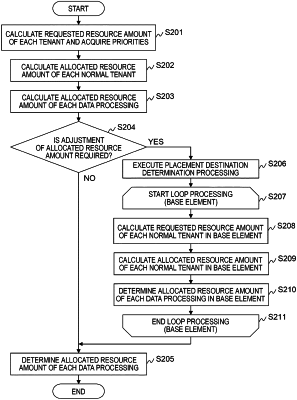| CPC H04L 47/781 (2013.01) [G06F 9/5038 (2013.01)] | 8 Claims |

|
1. A computer system, comprising:
at least one computer including a processor, a storage device connected to the processor, and a network interface connected to the processor,
wherein the system is connected to a base having a plurality of tenants,
wherein the tenant operates at least one service, each service composed of a plurality of data processing functions,
wherein the base includes a plurality of base elements for executing the data processing functions,
wherein resources of the base elements are allocated to the data processing functions, and
wherein the at least one computer is programmed to:
calculate a first allocated resource amount to be allocated to each of the plurality of tenants based on a requested resource amount requested by the plurality of data processing functions of each of the plurality of tenants and a first provided resource amount that can be provided by the base,
calculate a second allocated resource amount, for each data processing function within the base, to be allocated to the plurality of data processing functions of each of the plurality of tenants based on the requested resource amount requested by the plurality of data processing functions of each of the plurality of tenants and the first allocated resource amount of each of the plurality of tenants,
allocate resources to the plurality of data processing functions of each of the plurality of tenants based on the second allocated resource amount,
determine whether a total amount of the second allocated resource amount is greater than the first provided resource amount, and upon determining the total amount of the second allocated resource amount is greater than the first provided resource amount, execute arrangement destination determination processing for determining the base element to be an arrangement destination of each of the plurality of data processing functions of each of the plurality of tenants so that, for each tenant, a Euclidean distance representing the difference between a total amount of requested resources of the data processing functions on the base element and a second provided resource amount able to be provided by the base element is minimized.
|